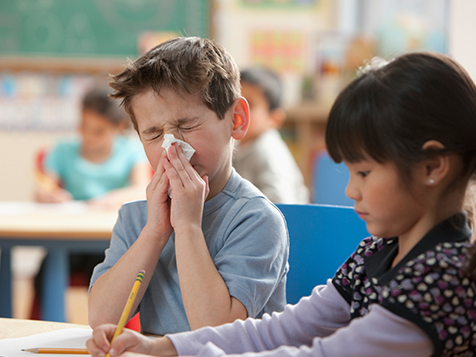 The flu in Alabama has increased for the second week in a row, according to the Alabama Department of Public Health. The number of cases in the state have increased, and most of the state is experiencing widespread flu activity.
The flu in Alabama has increased for the second week in a row, according to the Alabama Department of Public Health. The number of cases in the state have increased, and most of the state is experiencing widespread flu activity.
Cleaning and disinfecting frequently touched or used areas are an important way to prevent the spread of illness, especially in areas that are commonly touched by children, such as at home and at school. To protect yourself and your family from the flu, follow these disinfectant and cleaning guidelines recommended by experts at the University of Alabama at Birmingham.
Clean and disinfect surfaces and objects that are touched often
“Schools, day cares and workplaces are full of germs that lead to illnesses like the flu,” said Caroline Cartledge, a nurse and instructor at the UAB School of Nursing. “To slow the spread of the flu, clean commonly touched surfaces at least once a day, if not multiple times.”
According to the Centers for Disease Control and Prevention, these are the most commonly touched surfaces at schools:
- Desks
- Countertops
- Doorknobs
- Computer keyboards and mouses
- Toys and hands-on learning items
- Faucet handles
Cartledge adds to not forget to disinfect things that your children bring home from school.
“When your kids come home from school, it is a good practice to clean the things that are regularly touched during school, like backpacks, books and lunchboxes,” she said. “I suggest creating an area where you keep school work and school items, so you are not putting those things in areas where you cook or eat.”
The kitchen is another area that should be disinfected on a daily basis.
“Places you may not think to disinfect, like the refrigerator and freezer door handles, are full of germs,” Cartledge said. “Wipe those down with disinfectant wipes each day, especially at the end of each day. Those are areas that are frequently touched and used by your family, and although it may not appear to be dirty like a countertop or a stovetop, it could still be covered in germs that cause the flu.”
Another culprit of the spread of the flu — your cellphone.
“Clean your phone with a disinfectant wipe each day,” Cartledge said. “We are constantly touching our phones, holding them to our face and placing them on commonly used surfaces. I recommend cleaning your phone at the end of each day — front and back.”
The right way to clean and disinfect
Cleaning commonly touched items with soap and water is a start to disinfecting commonly touched and used areas, but it may not kill all of the germs.
“The easiest and most efficient way to clean is by using a disinfecting wipe of any kind,” Cartledge said. “However, make sure you are using a product that has been endorsed by the Environmental Protection Agency. If the EPA has approved the product, then you know it is approved to disinfect Influenza A.”
Follow these steps by the CDC to clean and disinfect items correctly:
- Wash surfaces with a general household cleaner to remove germs.
- Rinse with water.
- Use an EPA-registered disinfectant (like a Clorox wipe) to kill germs.
- Throw away disposable items used to clean surfaces immediately after use.
- Let the product remain on the surface for at least three to five minutes to make sure it kills all of the germs.
The correct way to dispose of waste
Having multiple wastebaskets in classrooms, workplaces and homes is a good way to dispose of tissues and napkins; but make sure you are disposing of items inside the right way.
Avoid touching tissues and other waste items. Wear gloves, and wash your hands with soap and water immediately after you dispose of the trash. Also, keep the wastebaskets in easy-to-see areas so people can dispose of their own tissues without others having to do it for them.
Finally, remind students and co-workers to frequently wash their hands, avoid touching their faces and to not eat or drink after each other.
For more information about how to protect yourself and your loved ones from the flu, visit the UAB Flu website. The site includes downloadable graphics to print out and place around schools, as well as tips on how to treat the flu, where to get a flu shot and where to get medical help.